Related Research Articles
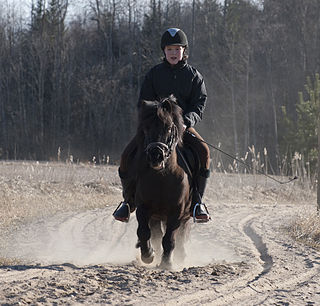
The Shetland pony is a Scottish breed of pony originating in the Shetland Isles in the north of Scotland. It may stand up to 107 cm (42 in) at the withers. It has a heavy coat and short legs, is strong for its size, and is used for riding, driving, and pack purposes.
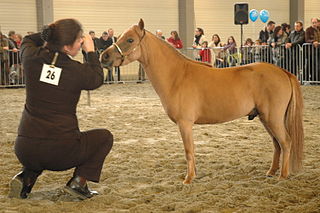
A miniature horse is a breed or type of horse characterised by its small size. Usually it has been bred to display in miniature the physical characteristics of a full-sized horse, but to be little over 100 cm (40 in) in height, or even less. Although such horses have the appearance of small horses, they are genetically much more similar to pony breeds such as the Shetland. They have various colors and coat patterns.

The Pony of the Americas is a pony breed developed in the state of Iowa in the United States. The foundation stallion was an Arabian/Appaloosa/Shetland pony cross. A breed registry was founded in 1954, and within 15 years had registered 12,500 ponies. Today, the Pony of the Americas Club is one of the largest and most active youth-oriented horse breed registries in the US. Although called ponies, POAs have the phenotype of a small horse, combining mainly Arabian and American Quarter Horse attributes. The registry is open, allowing blood from many other breeds, but has strict criteria for entry, including Appaloosa coloration, specified height and other physical characteristics. Although mainly bred for Western riding, the breed has been used for many other disciplines, including driving, endurance riding and some English disciplines.

The Hackney pony is a breed of pony closely related to the Hackney horse. Originally bred to pull carriages, they are used today primarily as show ponies. The breed does not have its own stud book, but shares one with the Hackney horse in all countries that have an official Hackney Stud Book Registry.
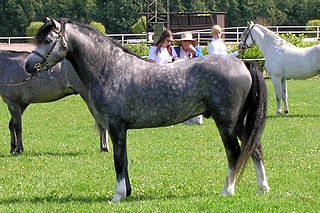
The Welsh Pony and Cob is a group of four closely-related horse breeds including both pony and cob types, which originated in Wales in the United Kingdom. The four sections within the breed society for the Welsh breeds are primarily distinguished by height, and also by variations in type: the smallest Welsh Mountain Pony ; the slightly taller but refined Welsh Pony of riding type popular as a children's show mount; the small but stocky Welsh Pony of Cob Type, popular for riding and competitive driving; and the tallest, the Welsh Cob, which can be ridden by adults. Welsh ponies and cobs in all sections are known for their good temperament, hardiness, and free-moving gaits.
The Welara is a part-Arabian pony breed developed from the Arabian horse and the Welsh pony. It was originally bred in England by Lady Wentworth at the Crabbet Arabian Stud in the early 1900s from imported Arabian stallions and Welsh pony mares. Breeding then spread throughout North America. In 1981, a breed registry was formed in the United States, and a studbook began to be published. They are used for many disciplines of English riding, and are known for their refinement, hardiness and spirit.

The Dogo Argentino is an Argentine breed of large dog of mastiff type. It was bred in the early twentieth century in Córdoba in central Argentina, primarily for dog-fighting, but also for hunting large game such as peccaries, wild boar and pumas. The foundation stock included a fighting dog of bulldog type, a Bull Terrier and a Mastín del Pirineo.

The Falabella is an Argentine breed of small horse. It is among the smallest of horse breeds, with a height at the withers in the range 63–86 cm (25–34 in)..

The Australian Pony is a breed of pony that developed in Australia. It was greatly influenced by the native British breeds, especially the Welsh Pony, as well as some Arabian bloodlines.

The grice was a breed of swine found in the Highlands and Islands of Scotland and in Ireland. It became extinct, surviving longest in the Shetland Isles, where it disappeared sometime between the middle of the 19th century and the 1930s. It was also known as the Highland, Hebridean or Irish pig.

The Shetland Islands of Scotland have long had their own distinct animal breeds, due to the remoteness of the archipelago. Below is a list of Shetland's domesticated animals.

Mountain and moorland ponies form a group of several breeds of ponies and small horses native to the British Isles. Many of these breeds are derived from semi-feral ponies kept on moorland or heathland, and some of them still live in this way, as well as being kept as fully domesticated horses for riding, driving, and other draught work, or for horse showing.

Fine harness is a type of driving competition seen at horse shows, that feature light, refined horses with high action. Popular breeds in this event include the American Saddlebred, Morgan, Arabian, Dutch Harness Horse, and Hackney (horse).
The Pinto Horse Association of America (PtHA) registers horses, utility horses, ponies and miniature horses of various pedigrees with certain kinds of pinto coat colors. The word pinto is Spanish for "paint." In general terms, pinto can apply to any horse marked with unpigmented pink-skinned, white-haired areas on its coat. The Pinto Horse Association of America provides the owners and riders of pintos with a show circuit and a breed organization. The primary requirement for PtHA registration is coat color; the pinto is not a true breed, but a color breed.

The American Shetland Pony is an American breed of pony. It derives from the traditional Shetland Pony from the Shetland Isles of Scotland, but as a result of cross-breeding with other horse and pony breeds, is taller and more elegant. It does not have the thick coat of the traditional Shetland, and in conformation is more similar to the Hackney Pony, with some Arab influence. It is the most numerous pony breed in the United States; numbers in 1994 were estimated at over 50,000. It is one of two American pony breeds derived from the traditional Shetland, the other being the Pony of the Americas.
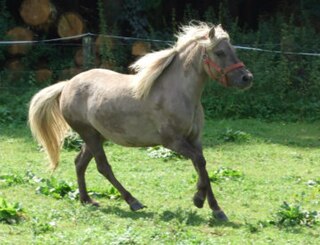
The German Classic Pony or German: Deutsches Classic-Pony is a modern German breed of riding pony. It derives from the traditional Shetland Pony of the Scottish Shetland Isles, but is principally influenced by the taller and more elegant American Shetland Pony.
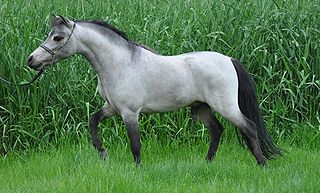
The American Miniature Horse is an American breed of small or miniature horse. It has been selectively bred to display in miniature the physical characteristics of a full-sized horse, and usually stands no taller than about 38 in (97 cm). It frequently has the appearance of either a small Arab or a small draft horse; genetically it is no different to pony breeds such as the Shetland.
References
- International Encyclopedia of Horse Breeds - written by Bonnie Hendricks - page 341